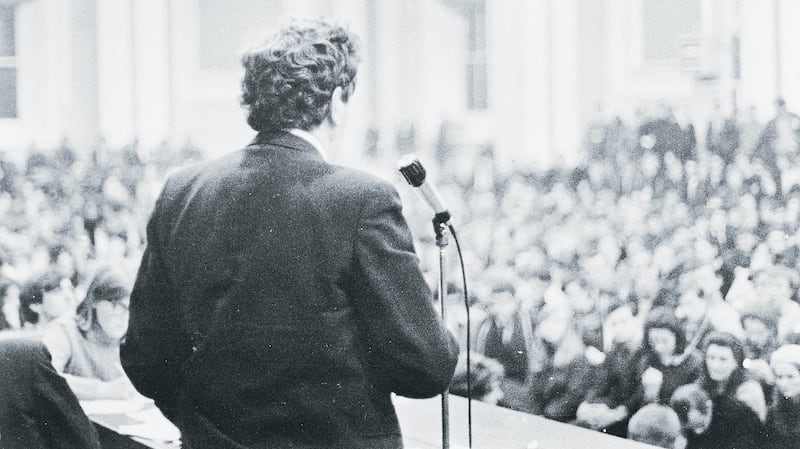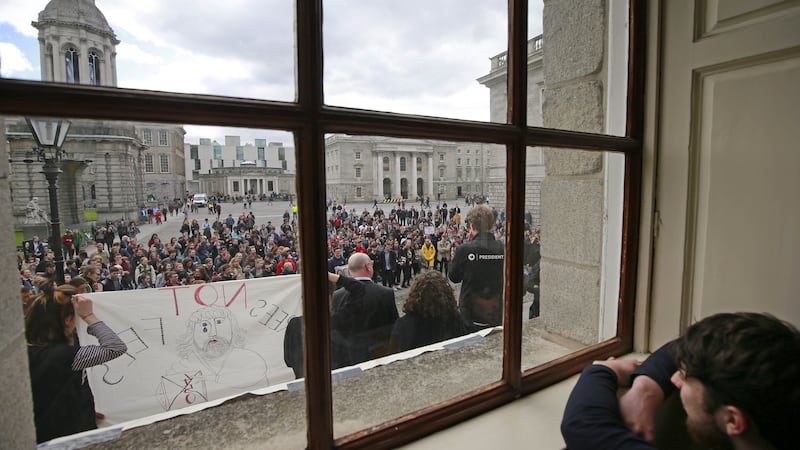In Paris, May 1968, a student protest over university reform drew a heavy-handed response from the authorities, leading to widespread worker strikes.
Indeed, the entire decade was a time of change and turmoil: in Pakistan, Poland, the US, Mexico, Czechoslovakia, Italy and the UK, students were in the vanguard of a movement demanding civil rights and radical social and political change.
The men in suits were scared. In Ireland, a small but influential group of UCD students decided to take action in 1968-69, sparking a series of events that became known as the "gentle revolution".

Ruairi Quinn, an architecture student who went on to become leader of the Labour Party and serve as education and finance ministers, was one of them. What happened, and what legacy has it left for today's student activists?
“I was involved in two parallel events,” Quinn, who was chair of the UCD Labour branch at the time, recalls.
“First, we protested about standards on the architecture course by occupying the building for about 48 hours, and it did lead to reforms and changes.
"Then, along with Kevin Myers, Una Claffey, Basil Miller and others, we were involved in a movement which ultimately saw a boycott of lectures and a student-led occupation of UCD at Earlsfort Terrace."
Main grievances
One of their main grievances was that UCD was “Catholic academy masquerading as a university”.
“We wanted a secular footing, better lecturers and a real student voice in the college’s governance. The junior staff, anxious to see progressive change, welcomed the initiative. It was a really exciting time for the people who were involved.
“There were all sorts of legacies from the 1940s and 50s that had not changed. This was a time when women were turned away by the head porter for coming to college in jeans, so we had a day of action where all the women were encouraged to come in jeans, and we collapsed that system.”
Students also protested at Trinity College and the National College of Art over campus issues.
At UCD, they formed “Students for Democratic Action”, closely linked to Labour, with a focus on direct action.
Quinn says the university responded by bringing about reforms including much-needed improvements in the library, but he was disappointed that “our expectations of radical social transformation never really happened”.
Arguably, the energy generated during the gentle revolution dissipated because, unlike in other parts of the world where the students had been met with violence, UCD agreed to many of their demands.
Civil rights movement
In addition, much of the energy of the island's students was absorbed by the Northern Ireland civil rights movement.
Two decades later, Cian O’Callaghan – now a Social Democrat councillor in Fingal – was heavily involved in student activism when he started at UCD in 1997.
He went on to serve two terms as an officer in the Union of Students in Ireland at a time when Fianna Fáil was the dominant force in student politics.
“I don’t know if the gentle revolution had any long-term effect in terms of motivating students,” he says.
“Arguably, the actions of UCD Students’ Union in the 80s, when they were at the forefront of providing abortion information for students and were brought to court by SPUC [the Society for the Protection of the Unborn Child], left a greater legacy for the students who came after them and fought for abortion rights.”
By 1997, student activism had become relatively inert. All that changed in the early 2000s when there was a resurgence of activism.
“A teacher strike in 2001 mobilised secondary school students, who took to the streets demanding that their voice be heard,” says O’Callaghan.
“At USI, we helped them form the Union of Secondary Students, which is still going strong today.”
There's always tended to be periods where one campus or another was more radical, says O'Callaghan but, in the early 2000s, a proposal by then minister for education Noel Dempsey to reintroduce third-level fees had a further galvanizing effect on students.
Issues of global concern
The parallels with the late 1960s were clear: there were a lot of issues of global concern including the early rumblings of the Iraq war and students were motivated.
In 2002, students blockaded Dempsey in the UCD veterinary building. In student activist circles, UCD became known as "red Belfield" after the election of Labour Youth candidate Paul Dillon (now a trade union official) as students' union president in 2003 – an election that was also contested by Paul Murphy, now a Solidarity Party TD.
Gráinne Griffin, who went on to serve as co-director of Together for Yes alongside Orla O’Connor of the National Women’s Council and academic and activist Ailbhe Smyth, was also involved in student activism and the fight to repeal the Eighth Amendment during this period.
Indeed, Griffin was calling for free, safe and legal abortion during her time in college; she was regularly told to temper her demands but, in hindsight, may have been among those who led the way.
The legacy
Today, student activism is on the rise again. In recent years, students have been at the forefront of social and political campaigns for affordable housing, the environment, abortion and mental health (see panel).
How does Quinn, one of the original protagonists of the gentle revolution, see the legacy of his time? “People will mobilise around issues that are relevant, not necessarily party-political. Change starts with a small number of people and gathers momentum.
“A lot of young people who were active in the late 60s went on to work in education and elsewhere, and they stayed energised,” he says.
“By the standards of that time, we were revolutionary, and taking an action like physical occupation changed the rules of engagement forever.”
#TakeBackTheCity #RepealThe8th. #MarRef : Student activism today
The past four years have seen unprecedented levels of engagement by students and young people in social and political issues, tackling issues including mental health, housing, the environment, abortion and LGBTI rights. Many of the housing protesters who occupied empty buildings are students.
USI president Síona Cahill says the marriage and abortion referendums activated young people.
“This wasn’t protest politics; it was change-making. Students saw that we can have successes and win. Students came from all over the country for last October’s lunchtime housing protest. That said, student activism is about more than street or direct action, and can take many forms including lobbying and campaigning.”
At Trinity College, #TakeBackTrinity saw students successfully defeat a college plan to hike exam fees last March, but their broader grievances reflect those of the gentle revolutionaries: issues around college governance and the style of leadership as well as pay and conditions of staff.

At DCU, NUI Galway and UCC, students have protested about the student accommodation crisis. Social media has helped their messages to spread – and reverberate.
This activism hasn’t translated into turnout for student union elections, which can hover as low as 10 per cent, although there are signs that this is changing, albeit slightly. This year, turnout at Trinity’s student union elections increased by 20 per cent.
At UCC, the recent election of students union president Alan Hayes saw a 33 per cent increase in turnout, with more than 5,000 of the 18,820-strong student body casting their vote.
Hayes won an active citizenship scholarship to UCC for his campaigning work on mental health and his establishment of the Thomas Hayes Trust to support families affected by suicide.
“The suicide of my father and, later, my brother, turned me into a campaigner,” he says. “I ran for SU president with a focus on improving student mental health support.
“In recent months, we’ve been campaigning on the student accommodation crisis and the rise in rents prompted by private providers. Students are paying up to €200 a week for a place to live. UCC have been great and helped those students who are struggling to find a place, but we need rent caps for purpose-built student accommodation.”










